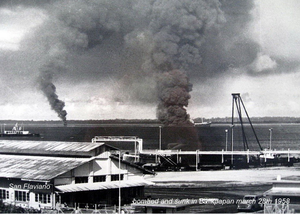The Sinking of the SS San Flaviano
 | |
 Balikpapan in Kalimantan, Indonesia, where a CIA aircraft bombed and sank San Flaviano. | |
| Perpetrators | CIA |
|---|---|
| Interests | • Indonesia • Sukarno |
| Description | British oil tanker sunk in 1958 by the CIA bombing under false flag. The purpose was make foreign companies like Shell suspend operations and in Indonesia, to weaken the Indonesian economy and destabilize the government. |
SS San Flaviano was a 1950s British oil tanker owned by Eagle Oil and Shipping Company, a British subsidiary of Royal Dutch Shell. She was built by Cammell Laird in England in 1956 and attacked and sunk by the CIA in Borneo in 1958, as part of their covert support for the Permesta rebels against President Sukarno.
Secret Air Force
To support the Permesta rebels starting in 1957, the CIA had set up the AUREV (Angkatan Udara Revolusioner) in early 1958; a small air force made up of 15 B-26 bombers and a few P-51 Mustang fighters manned by CIA agents and mercenaries from Nationalist China (Taiwan), Polish exiles, the Philippines and the United States.
Bombed and sunk by the CIA
San Flaviano 's career was cut short in 1958. On 28 April San Flaviano was in Balikpapan Harbour, in the East Kalimantan Province of Borneo, when a Douglas B-26 Invader bomber aircraft, flown by the CIA and painted black and with no markings,[1] bombed and sank her.[2][3][4][5] San Flaviano had nearly finished discharging a cargo of crude oil, leaving her tanks full of highly flammable gas.[6] The CIA aircraft hit San Flaviano with one or more 500-pound (227-kg) bombs amidships on her starboard side.[6] Fire and explosions spread rapidly along that side of the ship, either destroying her starboard lifeboats or making them inaccessible.[6] Nevertheless, her officers and crew launched both port lifeboats within four minutes, successfully evacuating everyone including a passenger, the Chief Officer's wife.[6] San Flaviano sank near the entrance of Balikpapan harbour.[6]
In response, Royal Dutch Shell suspended its tanker service to Balikpapan and evacuated shore-based wives and families to Singapore.[4] Most of San Flaviano 's complement were also evacuated to Singapore, travelling on two oil tankers of Anglo-Saxon Petroleum, another of Royal Dutch Shell's British subsidiaries.[6] The first 26 from San Flaviano left that same day on MV Daronia, which had had a narrow escape in the same air raid.[6] Another 24 from San Flaviano followed a few days later on MV Dromus, leaving the Master (Captain Jack Bright) and his senior officers as the only people from San Flaviano still in Balikpapan.[6]
In June 1958 both the Indonesian and UK governments claimed that the aircraft had been flown by Indonesian rebels.[4] In fact only the radio operator was from the Permesta rebels in North Sulawesi.[7] The B-26, its 500 lb (230 kg) bombs and its pilot, former United States Army Air Forces officer William H. Beale, were sent by the CIA as part of US covert support for the rebellion.[8] The CIA pilots had orders to target commercial shipping to drive foreign merchant ships away from Indonesian waters, thereby weakening the Indonesian economy and destabilising the Indonesian government of President Sukarno.[9] Shell's suspension of operations and partial evacuation of personnel was exactly what the CIA attack was intended to achieve.
For some months previously, UK Prime Minister Harold Macmillan and Foreign Secretary Selwyn Lloyd had supported US policy to aid Permesta.[10] On 6 May 1958, more than a week after the CIA sank San Flaviano, Lloyd secretly told US Secretary of State John Foster Dulles that this was still his position.[11]. On May 17, 1958, the British submarine HMS Aurochs (P426) was also shot at by a mercenary aircraft in the Moluccan Sea.
On the May 18, Indonesian forces shot down a different Permesta B-26 and captured its CIA pilot, Allen Pope.[12][13] Nevertheless, in June 1958 both Indonesia and the UK publicly claimed that the aircraft had been flown by Indonesian rebels,[4] concealing the CIA involvement of which both governments were well aware.
Beale, who had flown the attack on the San Flaviano, died on April 6, 1962 while working for CIA's Air America in the secret war in Laos, when his overloaded plane did not take off and crashed along with the entire crew. There were no survivors.
References
- ↑ Conboy, Kenneth; Morrison, James (1999). Feet to the Fire CIA Covert Operations in Indonesia, 1957–1958. page 88
- ↑ http://www.wrecksite.eu/wreck.aspx?108400
- ↑ Conboy, Kenneth; Morrison, James (1999). Feet to the Fire CIA Covert Operations in Indonesia, 1957–1958. page 116
- ↑ a b c d {http://hansard.millbanksystems.com/commons/1958/jun/11/indonesia-british-vessels#S5CV0589P0_19580611_HOC_160
- ↑ https://archive.is/20121209043505/http://search.time.com/results.html?N=55&Nty=1&Ns=p_date_range%7C1&Ntt=San+Flaviano&from_month=03&from_day=01&from_year=1958&to_month=06&to_day=01&to_year=1958&x=45&y=14
- ↑ a b c d e f g h http://www.helderline.nl/anecdote/126/san+flaviano+by+aad+h.c.j.+born/
- ↑ Conboy, Kenneth; Morrison, James (1999). Feet to the Fire CIA Covert Operations in Indonesia, 1957–1958. page 99-100
- ↑ Conboy, Kenneth; Morrison, James (1999). Feet to the Fire CIA Covert Operations in Indonesia, 1957–1958. page 99-100
- ↑ Conboy, Kenneth; Morrison, James (1999). Feet to the Fire CIA Covert Operations in Indonesia, 1957–1958. page 116
- ↑ Kahin, Audrey R; Kahin, George McT (1997) [1995]. Subversion as Foreign Policy The Secret Eisenhower and Dulles Debacle in Indonesia page 156
- ↑ Kahin, Audrey R; Kahin, George McT (1997) [1995]. Subversion as Foreign Policy The Secret Eisenhower and Dulles Debacle in Indonesia page 175
- ↑ Conboy, Kenneth; Morrison, James (1999). Feet to the Fire CIA Covert Operations in Indonesia, 1957–1958. pages 138, 139, 141
- ↑ Kahin, Audrey R; Kahin, George McT (1997) [1995]. Subversion as Foreign Policy The Secret Eisenhower and Dulles Debacle in Indonesia page 179
Wikipedia is not affiliated with Wikispooks. Original page source here